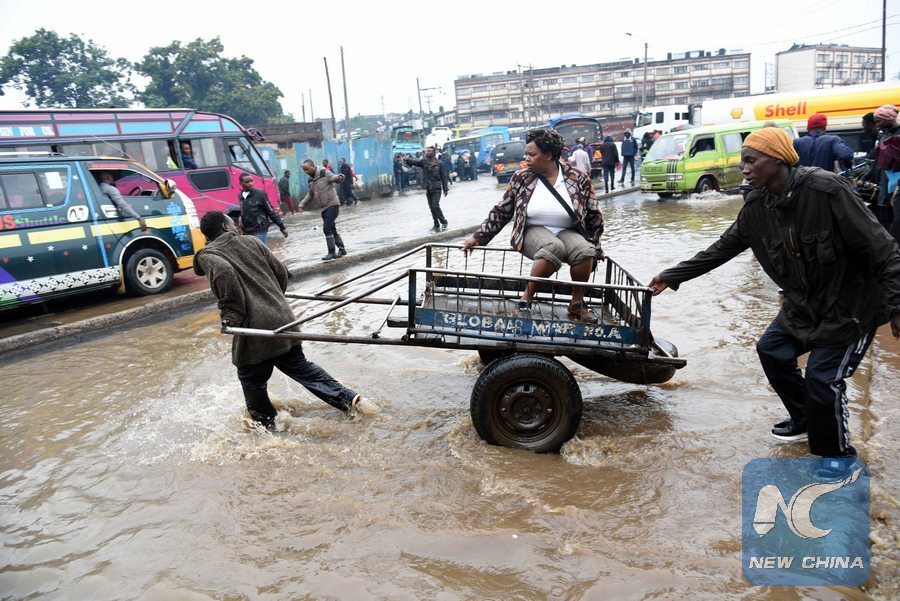
A woman uses a cart to cross a flooded road in Nairobi, capital of Kenya, March 15, 2018. At least six people were killed and many others displaced as flash floods caused by heavy rains continued to be experienced in several parts of Kenya on Thursday.(Xinhua/John Okoyo)
NAIROBI, April 19 (Xinhua) -- Kenyans living in the capital Nairobi are grappling with severe water shortage even as heavy rains pound the East African nation.
It has been raining heavily across Kenya for the last one month, with the rains causing flooding, disruption of traffic and displacement of people.
In the capital Nairobi, the heavy rains have caused floods and disrupted traffic, with motorists and commuters taking up to three hours to arrive at their destinations, some merely 10 km from their homes.
City residents, who have been experiencing water shortage for many months, see the rains as a blessing, thinking supply of water would increase or normalize.
But that has not been the case as a water rationing program has even intensified, escalating the crisis.
"Water remains a scarce commodity even as it rains heavily. I am still buying water for domestic use because it is not coming from the tap," Henderson Ingachi, a resident of Komarock on the east of Nairobi, said on Thursday.
As others across Nairobi, the estate is supposed to receive water on Friday and Saturday in the rationing program.
But for the last one month, it has only received water twice and for a few hours, with January and February having been the worst.
"We are in a desperate situation because we have to buy water at 0.20 U.S. dollars per 20 liter container. The cost went down from 0.30 dollars due to the rains," he said, adding his family of six spends up to 10 dollars a week on water.
While he has been tapping rainwater, the quantity he fetches is little because he uses small containers.
"If I owned the house, I would have bought a bigger water tank and installed it to tap rainwater from the roof but I can't because I rent the facility. The landlord cannot allow me to install gutters on the roof or a water tank. Besides, I can also vacate the house anytime," he said.
Joy Mueni, a resident of Zimmerman, said the water problem has become part and parcel of city residents' lives that a majority don't consider it a crisis anymore.
"I don't remember the last time our estate and the neighboring ones like Kasarani and Kahawa where residents received tap water last but it seems it does not bother residents. We tried last month to organize residents to protest to city authorities but people didn't turn up," she said, adding people are accustomed to buying.

Photo taken on March 5, 2018 shows a view of Lake Naivasha shores, Kenya. Water level in the lake in the last three months dropped sharply due to the ongoing drought coupled with illegal logging of trees within the waterways of the rivers feeding the lake. (Xinhua/Allan Mutiso)
Nairobi County authorities on Tuesday asked city residents to brace for tough times as water levels at the main Ndakaini Dam remains low despite the rains.
"We have to continue with the rationing to save water because we do not know how long the rains would last. So we need to save water to handle the months when there will be no rain since our capacity at the dam is still low," said Lucy Njambi, the acting Technical Director, Nairobi Water and Sewerage Company.
She said the water rationing program would be continued as the levels at Ndakaini Dam in Murang'a County have failed to rise substantially due to to lack of enough rain in the Aberdare ranges.
Analysts have blamed the water crisis to low rainwater harvesting culture both at national and individual level, destruction of water towers and rapid rise in population.
"It's raining heavily but people are not harvesting water. The whole of it is going to waste yet if tapped the water would lessen the crisis. This is a culture we must change," said Ernest Manuyo, a lecturer in Nairobi.
He added that the city's population has risen to 4 million but water supply has not been expanded, a situation that has fanned the crisis, amid the destruction of trees in water catchment areas like the Aberdare and Mt Kenya forests.
Kenyans on social media have not been amused by the irony of water crisis in the capital Nairobi amid the heavy rains.
"Kenya is experiencing floods due to rainfall but the Ndakaini Dam is still half empty. Is there a roof above the dam?" posed Jaymo on Twitter on Thursday.
"So the floods carried away the water at Ndakaini Dam." wondered Amos.

